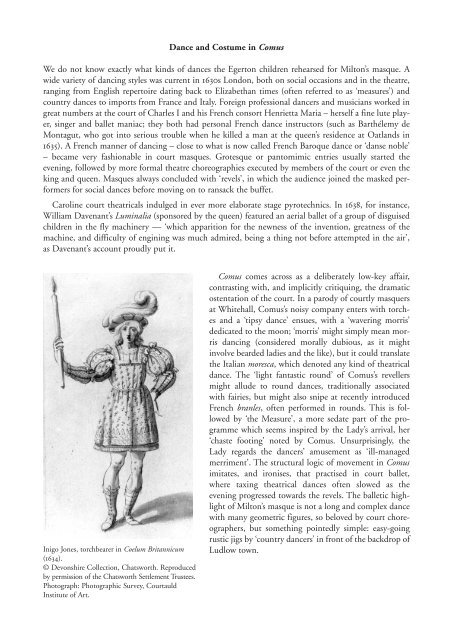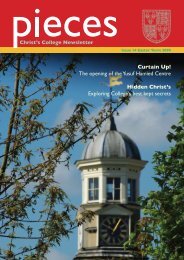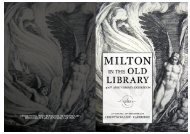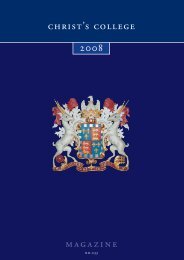here - Christ's College - University of Cambridge
here - Christ's College - University of Cambridge
here - Christ's College - University of Cambridge
Create successful ePaper yourself
Turn your PDF publications into a flip-book with our unique Google optimized e-Paper software.
Dance and Costume in Comus<br />
We do not know exactly what kinds <strong>of</strong> dances the Egerton children rehearsed for Milton’s masque. A<br />
wide variety <strong>of</strong> dancing styles was current in 1630s London, both on social occasions and in the theatre,<br />
ranging from English repertoire dating back to Elizabethan times (<strong>of</strong>ten referred to as ‘measures’) and<br />
country dances to imports from France and Italy. Foreign pr<strong>of</strong>essional dancers and musicians worked in<br />
great numbers at the court <strong>of</strong> Charles I and his French consort Henrietta Maria – herself a fine lute player,<br />
singer and ballet maniac; they both had personal French dance instructors (such as Barthélemy de<br />
Montagut, who got into serious trouble when he killed a man at the queen’s residence at Oatlands in<br />
1635). A French manner <strong>of</strong> dancing – close to what is now called French Baroque dance or ‘danse noble’<br />
– became very fashionable in court masques. Grotesque or pantomimic entries usually started the<br />
evening, followed by more formal theatre choreographies executed by members <strong>of</strong> the court or even the<br />
king and queen. Masques always concluded with ‘revels’, in which the audience joined the masked performers<br />
for social dances before moving on to ransack the buffet.<br />
Caroline court theatricals indulged in ever more elaborate stage pyrotechnics. In 1638, for instance,<br />
William Davenant’s Luminalia (sponsored by the queen) featured an aerial ballet <strong>of</strong> a group <strong>of</strong> disguised<br />
children in the fly machinery — ‘which apparition for the newness <strong>of</strong> the invention, greatness <strong>of</strong> the<br />
machine, and difficulty <strong>of</strong> engining was much admired, being a thing not before attempted in the air’,<br />
as Davenant’s account proudly put it.<br />
Inigo Jones, torchbearer in Coelum Britannicum<br />
(1634).<br />
© Devonshire Collection, Chatsworth. Reproduced<br />
by permission <strong>of</strong> the Chatsworth Settlement Trustees.<br />
Photograph: Photographic Survey, Courtauld<br />
Institute <strong>of</strong> Art.<br />
Comus comes across as a deliberately low-key affair,<br />
contrasting with, and implicitly critiquing, the dramatic<br />
ostentation <strong>of</strong> the court. In a parody <strong>of</strong> courtly masquers<br />
at Whitehall, Comus’s noisy company enters with torches<br />
and a ‘tipsy dance’ ensues, with a ‘wavering morris’<br />
dedicated to the moon; ‘morris’ might simply mean morris<br />
dancing (considered morally dubious, as it might<br />
involve bearded ladies and the like), but it could translate<br />
the Italian moresca, which denoted any kind <strong>of</strong> theatrical<br />
dance. The ‘light fantastic round’ <strong>of</strong> Comus’s revellers<br />
might allude to round dances, traditionally associated<br />
with fairies, but might also snipe at recently introduced<br />
French branles, <strong>of</strong>ten performed in rounds. This is followed<br />
by ‘the Measure’, a more sedate part <strong>of</strong> the programme<br />
which seems inspired by the Lady’s arrival, her<br />
‘chaste footing’ noted by Comus. Unsurprisingly, the<br />
Lady regards the dancers’ amusement as ‘ill-managed<br />
merriment’. The structural logic <strong>of</strong> movement in Comus<br />
imitates, and ironises, that practised in court ballet,<br />
w<strong>here</strong> taxing theatrical dances <strong>of</strong>ten slowed as the<br />
evening progressed towards the revels. The balletic highlight<br />
<strong>of</strong> Milton’s masque is not a long and complex dance<br />
with many geometric figures, so beloved by court choreographers,<br />
but something pointedly simple: easy-going<br />
rustic jigs by ‘country dancers’ in front <strong>of</strong> the backdrop <strong>of</strong><br />
Ludlow town.





